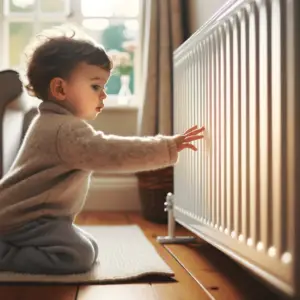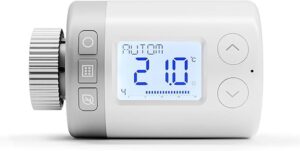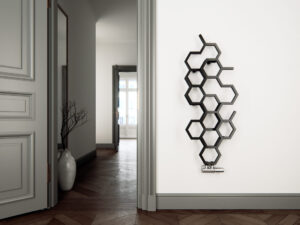Are you looking to calculate how many radiators your room needs with a BTU calculator? Rest assured, you’ve come to the right place! We’ve done all the hard calculations for you so all you need to do is enter your room type, size and heat loss features then we’ll provide you with the perfect amount of BTU’s to keep your room toasty warm all year round.
Accurately Calculate How Much Heat Your Room Needs with our Free Radiator BTU Calculator (UK)
Our accurate and free radiator BTU heating calculator is a great way to find out how many radiators your room needs to keep it warm based on several factors. We take into account the room size and type and combine it with heat retention metrics (such as double glazing windows) to calculate the perfect amount of heat required for your room.
All you need to do is enter the dimensions of your room and our radiator calculator will show you exactly how many BTU’s we recommend.
How Many BTU’s do I need?
This will depend on a number of factors such as room size and heat loss. However, most standard-sized rooms fall between the range of 2000 – 6000 BTUs. You can work out your required heat with our free BTU calculator by entering the details of your room. Or, if you prefer you can work out the BTUs manually by following our guide below.
STEP 1 | Which Room Are You Heating?
STEP 2 | What Size Is The Room?
STEP 3 | Heat Features Of Your Room
STEP 4 | See Your Results
Browse Radiators By BTUs Heat Output:
Great! Now that you’ve worked out the number of BTUs you need, simply click on the links below to find the perfect radiator design which matches your heat output requirement (please allow 2-5 seconds for the new tab to open on our partner site Best Heating):
Low output
Medium output
Save 10% On Radiators this Year (10% OFF Orders of £500)
Use code SAVE500 to get 10% off any order over £500 at Best Heating! Plus, there’s currently 30% off hundreds of radiators!
Click here for the > RADIATOR DEALS
What size radiator do I need?
The size of radiator that you need will depend on the total heat output required for your room. Once you have calculated the heat requirement with our BTU calculator you can then divide this figure by the amount of radiators that you would like in this room. For example, a room requiring 2000 BTUs could have 1 large vertical radiator (producing 2000 BTUs), or you could have 2 small horizontal radiators (each producing 1000 BTUs) to make a total of 2000 BTUs.
Of course, there are other factors to consider such as the amount of wall space available, the depth available on the wall (double panel radiators provide more heat but take up more space into the depth of the room). For more information on this, check out our guide on how to measure a radiator.
What is a BTU?
A BTU (or British Thermal Unit) is a measurement of heat used to qualify the amount of energy required to heat up one pound of water by one degree Fahrenheit, which equates to roughly 1050 Joules of energy. The BTU is most commonly used in the UK to measure heat output for radiators, fireplaces and heaters. Although, BTU’s are also used for measuring air conditioning, steam, energy and power in various countries across the world.
A common analogy to explain the equivalent energy of 1 BTU is to imagine the energy given off by a single burning match.
Why is it important to have the correct amount of BTU’s?
It is important to have the correct amount of BTU’s because if there isn’t enough heat being produced from the radiators or heating system, this could lead to cold spots appearing around the house. At Heat Adviser, we would always recommend going slightly above the recommended BTU output as you can always turn your radiators down but if you’ve gone too low then you’ll need to upgrade to larger radiators that produce a greater heat output.
Which Radiators provide the best BTU output?
If you’re looking for radiators that generate an incredibly high BTU heat output, then we would recommend cast iron radiators. However, the heat output of a radiator is associated with several factors such as the material, size, water content, surface area and water flow so be sure to check the technical specifications of the radiator before making a purchase.
How is room BTU heat requirement calculated?
To calculate the BTUs for your room, you need to multiply the dimensions of your room with the set figure for each room type. Then, you’ll need to add or subtract a percentage from the total BTU figure based on the presence or absence of certain heat retention features such as double glazing or patio French doors.
1. Measure The Dimensions of Your Room & Calculate Total Volume
Enter your room dimensions in either Feet or Metres and our calculator will multiply them together to get the total cubic volume of your room. The larger your room, the more BTU’s your room will require in order to be heated sufficiently. If you’re doing this manually, you’ll need to multiply your three measurements together to calculate the total volume of the room.
You can use either metric or imperial to measure your room. However, it is easier to use (Ft) instead of (M) as it removes an extra step from the process. If you use Metres you’ll need to multiply your final BTU measurement by 35.31 (this is because there are 3.28 Feet in every Metre, and when you’re working in 3 dimensions you need to use 3.28 cubed (3.28³ = 35.31).
2. Determine Room Type And Multiply Room Volume by Multiplication Factor
Below, you can see the the multiplication figure attributed to each type of room in the home. For the bathroom should be the warmest room in the home, hence the larger multiplication factor. Whereas, the hallway is often cooler and, therefore, has a lower multiplication factor:
| Room Type | Ideal Temperature | Multiplication Factor |
| Bedroom | 16°C – 19°C | 4.5 |
| Kitchen | 18°C – 20°C | 3.5 |
| Bathroom | 22°C – 24°C | 5 |
| Living Room | 20°C – 22°C | 4.5 |
| Dining Room | 19°C – 21°C | 3.5 |
| Hallway | 15°C – 18°C | 3 |
3. Take room heat loss & heat retention features into account
There are many features that will effect the speed at which heat is lost from your room. For example, if you have multiple single glazed windows with no ceiling insulation then you’ll require more BTU’s than a central, smaller room which is sheltered by neighbouring warm rooms.
You can refer to our multiplication factors to understand what effect each heat retention feature has on the total BTU output required for a room:
| Heat Feature of Room | Multiplication Factor |
| Double Glazing | 0.9 |
| Southern Facing Windows | 0.85 |
| Patio French Doors | 1.2 |
Other heat loss features to be consider are:
- Wall insulation
- Floor insulation
- Window Surface Area
- Number of Outside Walls
- Heated Room Below
Once you have completed these steps and multiplied your room volume in Feet by your room’s multiplication factor and finally the room’s heat loss factors then you should come up with a final BTU value for your room.
Example:
Room Dimensions
Height = 8Ft
Width = 12Ft
Length = 10Ft
Room Volume
= (8 x 12 x 16) = 960
Room Type
= Bathroom (Multiplication factor = 5)
960 x 5 = 4800
Room Heat Features
Double Glazing = (Multiplication factor = 0.9)
Total = 4800 x 0.9 = 4320 BTU






